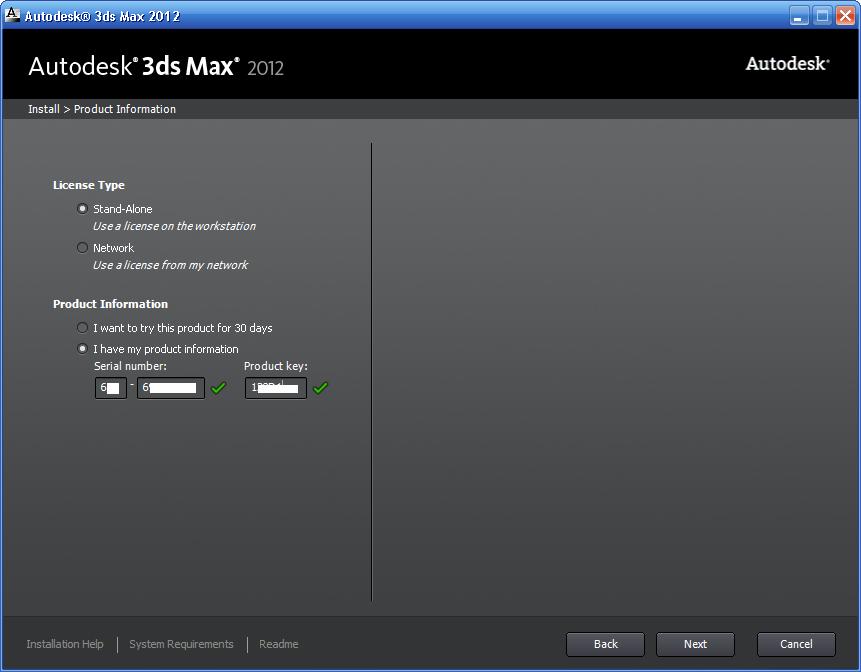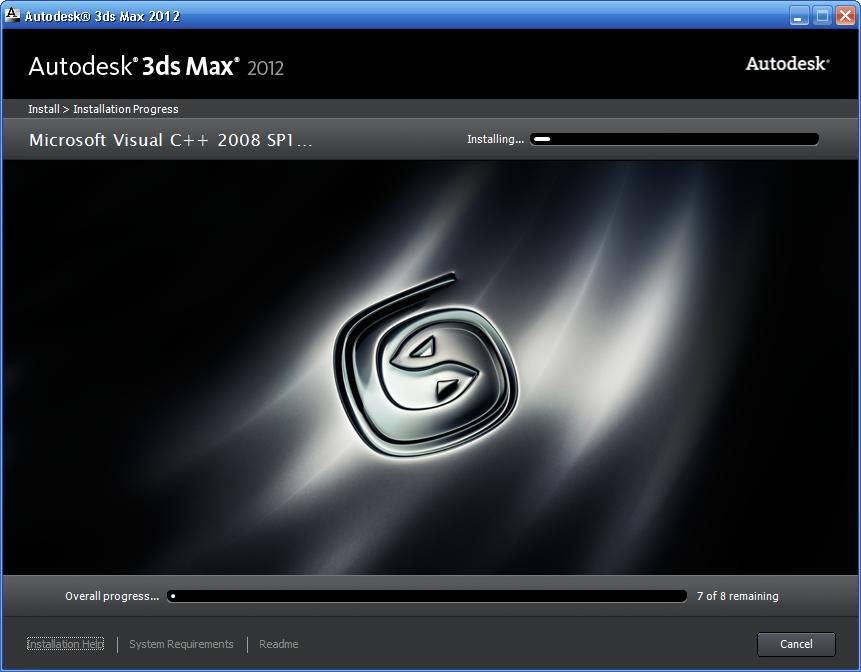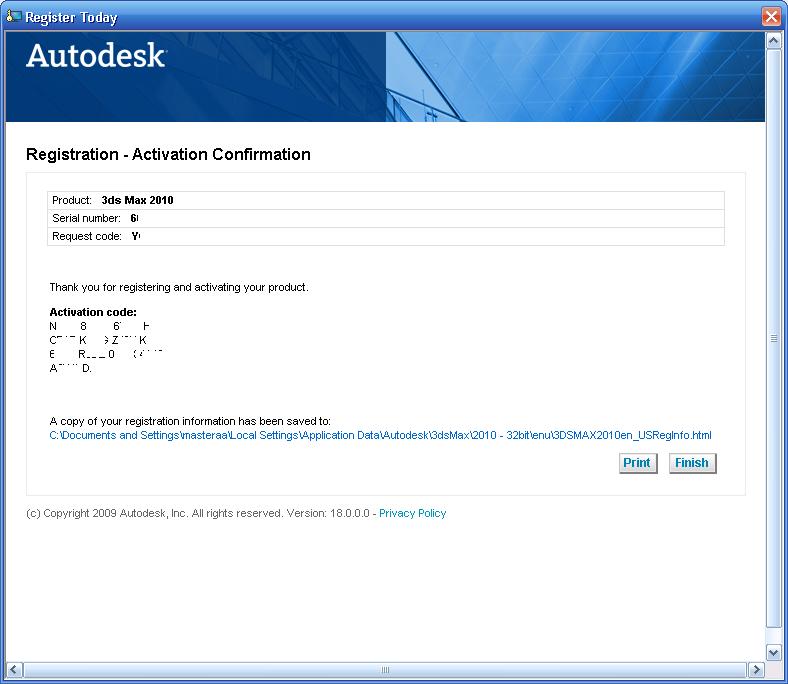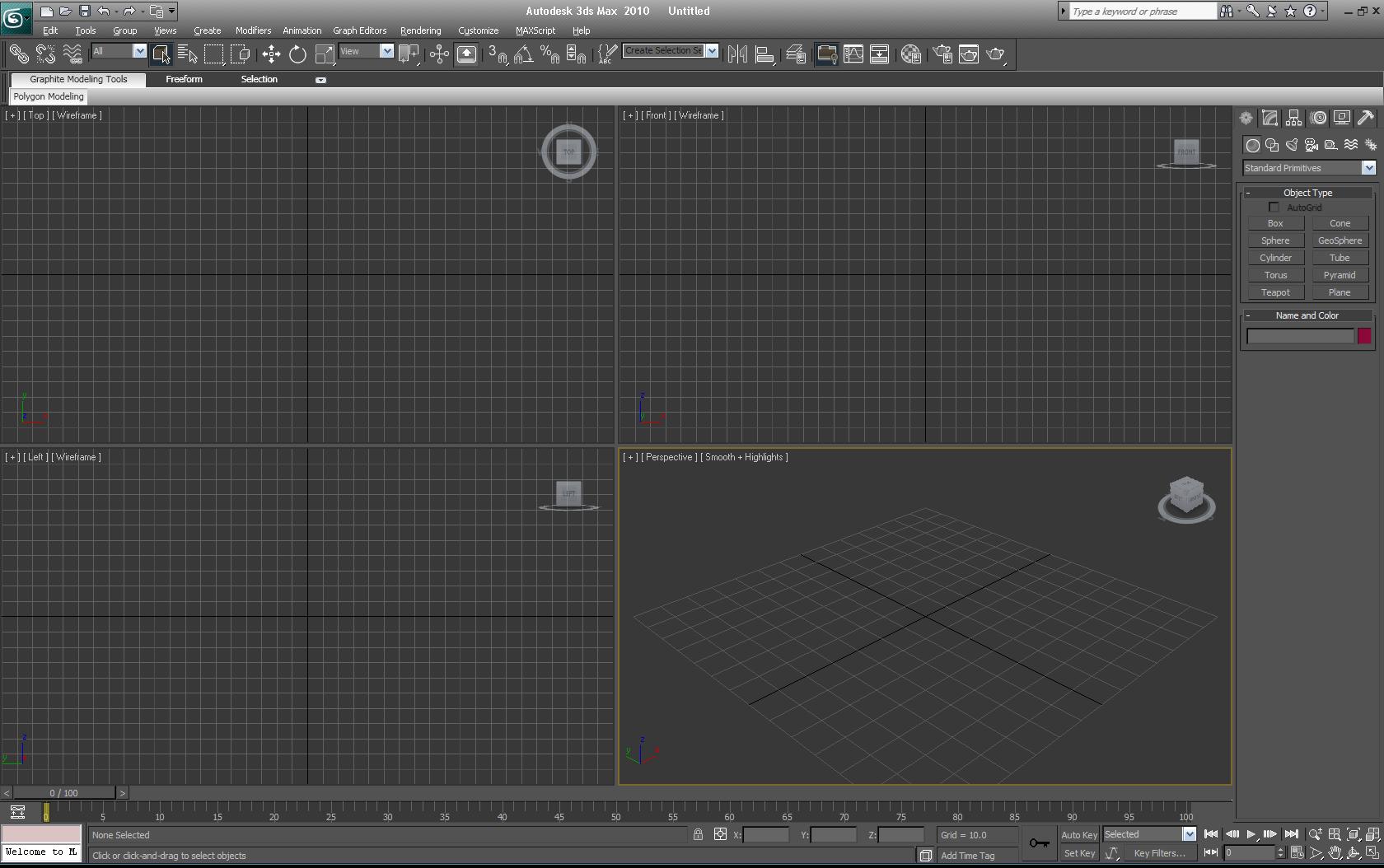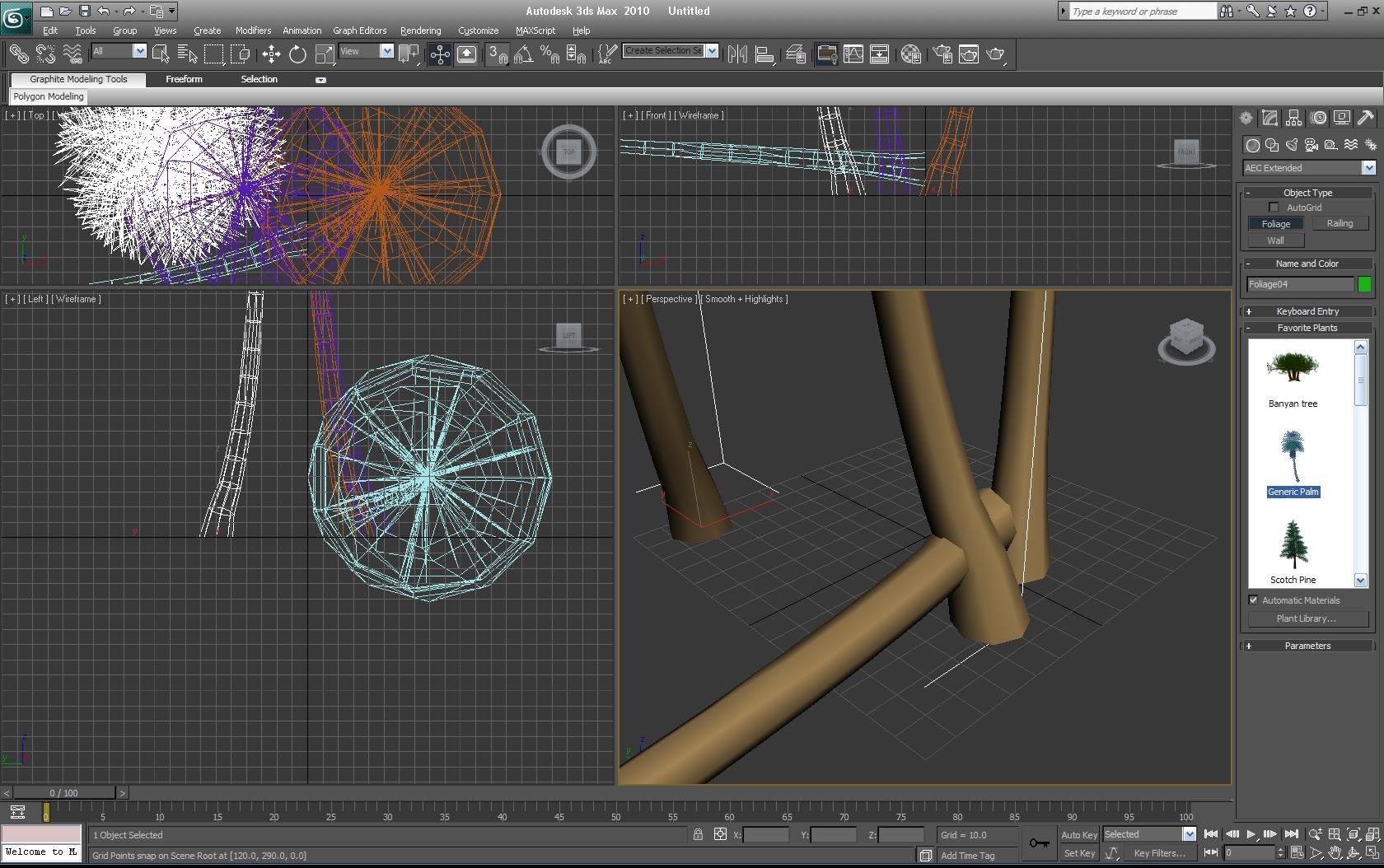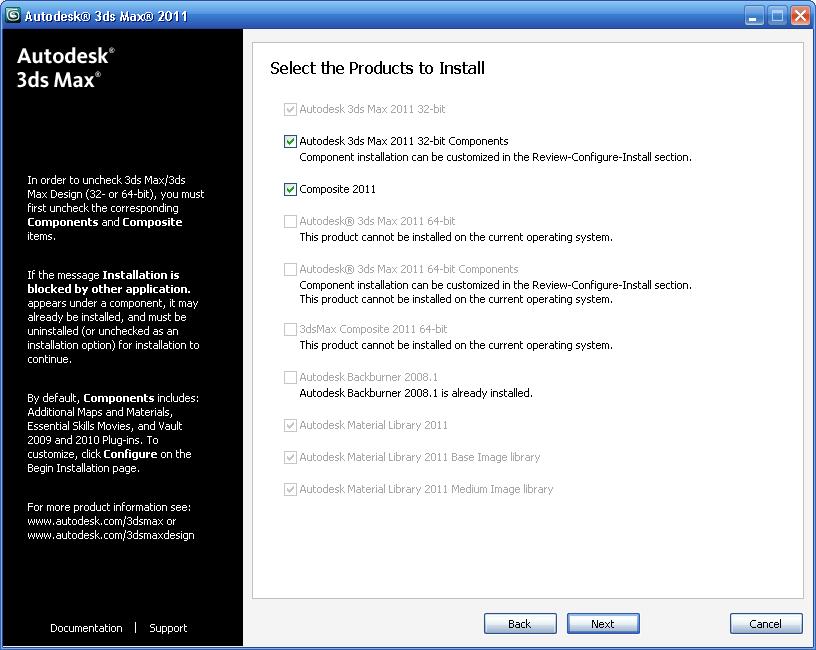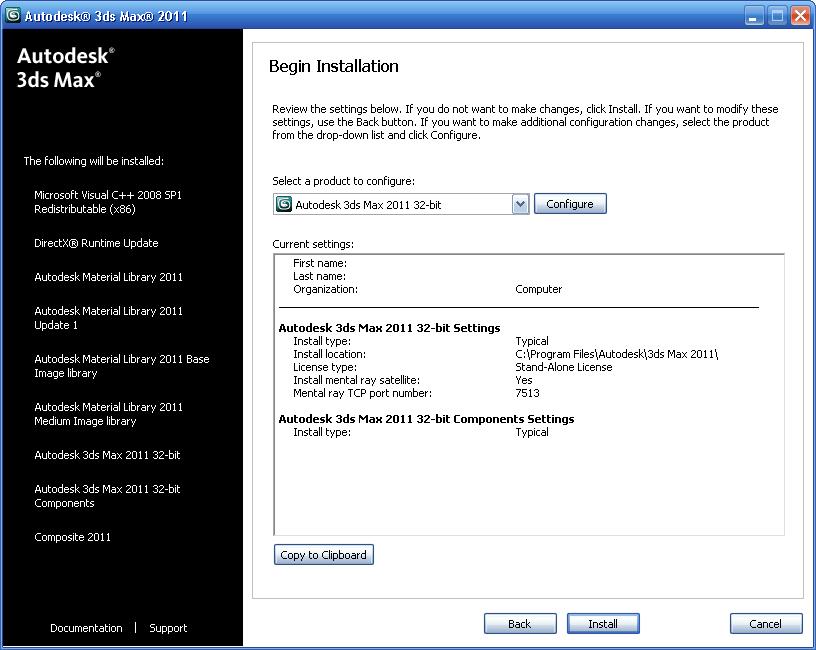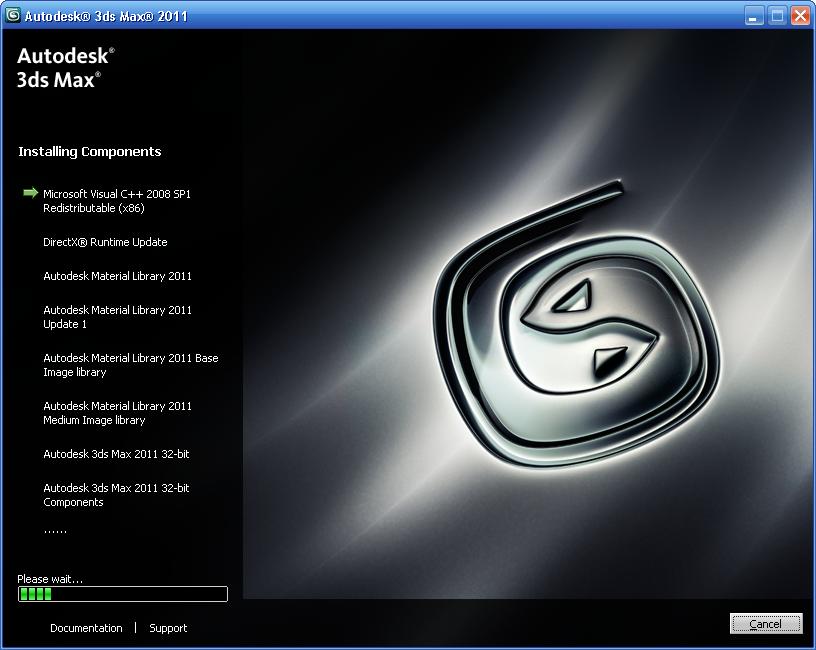| К странице... |
|---|
3D Studio Max Collection - All 3D Studio Max Versions [1995-2011][x86, x64] [ML]

|
Список форумов Tapochek.net » Программное обеспечение » Создание и редактирование мультимедиа и 3D контента » Архив (Программы для работы с мультимедиа и 3D) |
|
|
| Автор | Сообщение
|
|
|---|---|---|
|
3D Studio Max Collection - All 3D Studio Max Versions [1995-2011][x86, x64] [ML] • Название Программы: 3D Studio Max Collection • Версия программы: All 3D Studio Max Versions • Год выпуска: 1995-2011 • Платформа: 32bit, 64bit • Язык интерфейса: ML • Разработчик: • Автор: • Лечение: Присутствует • Системные тебования:
Autodesk 3ds Max — наиболее популярное программное обеспечение для 3D-моделирования, анимации и визуализации. Включает высокопроизводительные инструменты, необходимые для создания зрелищных кинофильмов и телевизионных заставок, современных компьютерных игр и презентационных материалов. Первая версия пакета под названием 3D Studio DOS была выпущена в 1990 году. Разработками пакета занималась независимая студия Yost Group, созданная программистом Гари Йостом; Autodesk на первых порах занимался только изданием пакета. Существуют сведения, что Гари Йост покинул прежнее место работы после переговоров с Эриком Лайонсом (Eric Lyons), в то время директором по новым проектам Autodesk. Первые четыре релиза носили наименование 3D Studio DOS (1990—1994 годы). Затем пакет был переписан заново под Windows NT и переименован в 3D Studio MAX (1996—1999 годы). Нумерация версий началась заново. В 2000—2004 годах пакет выпускается под маркой Discreet 3dsmax, а с 2005 года — Autodesk 3ds MAX. Актуальная версия носит название Autodesk 3ds MAX 2012 (индекс 14.0).
3ds Max располагает обширными средствами для создания разнообразных по форме и сложности трёхмерных компьютерных моделей, реальных или фантастических объектов окружающего мира, с использованием разнообразных техник и механизмов, включающих следующие:
• Scanline Визуализатор по умолчанию в 3ds Max. Исходным методом визуализации в 3DS Max является сканирующий построчный алгоритм. Некоторые расширенные возможности были добавлены в Scanline спустя годы, такие как расчёт Global Illumination, Ray Tracing и Radiosity, однако большинство функций перешло к нему от других визуализаторов (например — RadioRay). • Mental Ray Mental Ray является пригодной для производственного применения высококачественной системой визуализации, разработанной компанией Mental Images. Mental Ray встроен в последниe версии 3DS Max, это мощный инструмент визуализации, поддерживающий сегментную визуализацию (подобно механизму сопровождающей визуализации, реализованному в Maya), а также технологию распределённой визуализации, позволяющую рационально разделять вычислительную нагрузку между несколькими компьютерами. Включаемая в 3ds Max версия mental ray поставляется с набором инструментария, позволяющим относительно просто создавать множество различных эффектов. • V-Ray Высококачественный, фотореалистичный визуализатор, спроектированный в качестве плагина для 3ds Max. Популярнейший в русскоязычном пространстве внешний визуализатор компании Chaos Group. Очень часто используется профессионалами, часто заменяя стандартный Scanline и Mental Ray. Даже при стандартных настройках достигается высокое качество визуализации. По скорости визуализации опережает Mental Ray. Совместим с более старыми версиями 3ds Max. • RenderMan Стороннее средство подключения к конвейеру RenderMan, также полезно в тех случаях, когда требуется интеграция 3DS Max с системой визуализации Renderman. Конект с 3DS Max происходит с помощью DoberMan. • FinalRender Внешний визуализатор компании Cebas. Является наиболее полным фотон-основанным визуализатором, уступая по своим возможностям только MentalRay. Преимущество заключается в плотной интеграции с другими решениями Cebas, обеспечивающими широкий спектр разнообразных атмосферных, линзовых эффектов и пр., чего нет у других визуализаторов. • Brazil R/S Высококачественная, фотореалистичная система визуализации изображения, разработанная компанией SplutterFish Llc. В этом визуализаторе присутствует несколько алгоритмов просчёта глобального освещения Global Illumination: QMC и Photon Mapping. Brazil хорошо зарекомендовал себя среди архитекторов, дизайнеров и художников компьютерной графики, благодаря простоте настроек, стабильности и качественному результату визуализации. • Fryrender Фотореалистичный, основанный на законах физики, спектральный визуализатор. Создан компанией RandomControl. Предоставляет возможность получать изображения высочайшего качества и достигать естественного реализма. • Indigo Renderer Физически корректный рендер. Основная особенность его в том, что все расчеты света, энергии, каустики и т. д. происходят взаимозависимо, что и отличает его от других рендеров, где всё раздельно и определяется самим пользователем. • Maxwell Render Является первой системой визуализации, в которой принята «физическая парадигма». В основу всей системы положены математические уравнения, описывающие поведение света. Вводя в обращение реальные физические законы, Maxwell Render позволяет избежать длительного и тонкого процесса настройки параметров визуализации, который имеет место в случае большинства визуализаторов, работающих по иным алгоритмам. • LuxRender Система физически корректной визуализации трехмерных сцен, имеющая открытый исходный код. Для использования системы LuxRender, необходимо экспортировать сцены и модели из редакторов графики с помощью специальных плагинов или скриптов. • Kerkythea Система визуализации, позволяющая создавать фотореалистичные изображения. Использует физически точные материалы и освещение. Kerkythea 2008 Echo имеет свой собственный редактор сцены и материалов, обладает простым и удобным интерфейсом. • Arion Render Гибридный, интерактивный рендер GPU+CPU, разработанный компанией RandomControl, на базе NVIDIA CUDA. • BIGrender Рендер, способный визуализировать большие изображения. В процессе визуализации разбивает изображение на части и каждую часть сохраняет в отдельном файле. • Sunflow Система визуализации, позволяющая создавать фотореалистичные изображения, имеющая открытый исходный код. Система Sunflow написана на языке программирования Java. Ориентирован на визуализацию в сфере дизайна. 3ds Max обладает довольно обширной базой стандартных средств, облегчающих моделирование всевозможных спецэффектов. Помимо стандартной базы существует масса дополнительных средств (плагинов) позволяющих не только создавать значительно более реалистичные эффекты огня, воды, дыма, но содержащие дополнительные инструменты моделирования. Плагины являются внешними встраиваемыми модулями, которые продаются отдельно от пакета 3ds Max или же распространяются бесплатно через Интернет. Данные программы создаются как крупными компаниями, специализирующимися по разработке программного обеспечения, так и простыми разработчиками-энтузиастами. Дополнительных модулей для 3ds Max настолько много, что количество инструментов предлагаемых ими во много раз превосходит комплект стандартных средств 3ds Max. Плагины упрощают выполнение многих задач — например, позволяют расходовать меньше времени на просчёт визуализации (за счёт более усовершенствованных подключаемых визуализаторов) или ускоряют моделирование объектов, благодаря разнообразным модификаторам и дополнительным функциональным возможностям. Такие дополнительные модули как Particle Flow, Cloth FX, Reactor, — стали настолько популярны, что было решено интегрировать их в программу 3ds Max и теперь они являются частью программы. Ниже представлен список некоторых плагинов для 3ds Max:
Released on 1995 Was officially announced at Siggraph 1995 and shipped to users in April 1996. At the same time, the Autodesk Multimedia Division was rebranded as Kinetix, a division of Autodesk. Thus the full name of the official product was Kinetix 3D Studio MAX. The product contained about the same feature set as 3D Studio DOS R4 but implemented all tools using a completely new object-oriented, procedural modeling paradigm featuring the Modifier Stack, an easier to use linear version of the Prisms/Houdini procedural pipeline. Some elements like the Material Editor and the animation controller system were largely enhanced compared to the DOS version, and the render subsystem allowed for volumetric effects and 3rd party plug-in renderers (which started appearing shortly after the first release - RayStudio and RayMax being the first two available). Release 1.0 required Windows NT 3.51 and supported the first 3D Labs GLiNT hardware accelerator cards available for the PC via custom Heidi drivers. There were two point updates - 1.1 and 1.2. The SDK shipped with 1.1. 1.2 was an update to support WinNT 4 which featured the Windows95-style UI. Released on August 4th 1997 (code name Athena) Was officially announced as Siggraph 97 in LA,CA on August 4th 1997 and shipped to customers on September 24th, 1997. It included over thousand new features and workflow improvements. The most notable additions were Ray-tracing in the Scanline renderer via Raytrace materials and maps developed by Blur Studio's Steven Blackmon and Scott Kirvan (who later split to form Splutterfish and develop another popular renderer - the Brazil r/s). Lens Effects Post Effects licensed from Digimation NURBS modeling tools MAXscript programming language licensed from John Wainwright/Lyric Media OpenGL support There was one point release - 2.5. It was the first and only non-free point release in the history of 3D Studio and included among other enhancements NURBS additions (support for Trims) and VRML import support. Released on April 1999 (code name Shiva) Was announced at the Game Developers Conference in April 1999 on San Jose, CA and was released to customers on June 15th 1999. It was the last version to be published under the Kinetix logo, although the division was already merged with Discreet Logic but had no Corporate Identity design yet. The core of the program was largely rewritten to allow better integration of MAXscript and the Scanline Renderer was enhanced with support for pluggable Anti-Alias filters and Supersamplers. The User Interface was redesigned to support larger true-color icons on customizable tabbed toolbars where custom Macroscripts could be placed by the user. Released on 2000 (code named Magma) Was initially announced at Siggraph 2000 in New Orleans in an early technology demo. It featured among many other things a new IK system, QuadMenus context menus and a unified ActionItems UI customization system, ActiveShade render preview mode, a redesigned Modifier Stack (Stack View) with support for Drag And Drop, new Editable Poly modeling toolset, DirectX Shader support in viewports, ActiveX support in scripted rollouts, MultiRes mesh optimization based on Intel technology and more. There were two point releases to individual customers - 4.1 and 4.2, and a special 4.3 update which was for Educational users (schools, universities) only. (code named Luna) Was the first release ever to support the plug-in format of the previous version. Plug-ins developed for 3dsmax 4 could be used in 5 without a recompile, while both 2 and 3 required completely new versions. The biggest addition to 3dsmax 5 was the Advanced Lighting sub-system of the Scanline Renderer where two new plug-ins were introduced - a brute-force Global Illumination module called Light Tracer and a Radiosity module based on further research by the developers of Lightscape. (Historical note: Lightscape was acquired by Discreet Logic a couple of years before the Autodesk acquisition.) This also incl. Photometric and Day lights support. Further additions were the inclusion of Reactor (previously a separate plug-in published by Discreet based on the HAVOK dynamics engine); Set Key animation mode a refactored Track View with Curve Editor and Dope Sheet modes and an enhanced UVW Unwrap editor Render To Texture feature New Named Selection Sets editor New Transform gizmos Character Assembly and Bone Tools Spline IK Gimbal rotation mode Auto-Tangent interpolation Improved Skin Modifier with Weight Table Improved HSDS modifier UI Support for Layers (taken from 3ds VIZ) Ink'n'Paint Material Translucent shader On the human resources side, it is interesting to note that the product was developed under Chris Ford, previously senior Maya product manager who moved to Discreet when Alias dropped Wavefront. (He is now PRman business director at Pixar). Other related 3D Trivia: Bob Bennett, previously product manager for 3d Studio DOS, was Maya Development Manager for many years until the Alias acquisition by Autodesk - he is now with Luxology. There were three point updates - 5.1, 5.1SP1 and 5.5 (the latter was the extended version with the Particle Flow extensions). Once again required recompiled plug-ins (which later would be usable in 7 and 8). The main new features were mental ray as alternative renderer Particle Flow (previously shipped as an Extension to 5 for users on subscription), a refactored Schematic View Shell modifier new Vertex Paint Reactor 2 dynamics network support for Render To Texture (code named Catalyst) Was an evolutionary update on top of the 3dsmax 6 core. Main new features were: new Editable Poly tools incl. Bridge, Deform and Relax painting, Soft Selections Painting, Preserve UVs option etc. new Edit Poly modifier which was supposed to ship as Extension to 6 but made it into 7. Support for Normal mapping generation and rendering mental ray 3.3, incl. Sub-Surface Scattering and Ambient Occlusion shaders and Render To Texture support Per-Pixel camera mapping Flat shaded view Character Studio 4.3 included in the base package SkinMorph and SkinWrap modifiers TurboSmooth modifier Parameter Collector Refactored Reaction controller (formerly known as Reactor controller) Walk-Thru mode for First Person navigation in the viewports. Released on 2005 (code named Vesper) Was published in the Fall of 2005 and was the first release in the history of the product not to break the SDK compatibility in a 3rd major update - in other words, plug-ins from 6 and 7 could be used in 8 without the need for a recompile. The Discreet division of Autodesk was moved closer to the Mother Ship and turned into "Autodesk Media and Entertainment Division", AMED or Autodesk ME for short, leading to a full circle in the history of the 3D Studio line which started as Autodesk 3D Studio in 1990. The "M" in "Max" was capitalized again. Main new features were: Asset Tracking with support for 3rd party solutions and Autodesk Vault shipping with the package. Enhanced XRefs MAXscript Debugger Support for Scene States Hair and Fur (shipped as Extension to 7 earlier that year, based on Joe Alter's Shave & Haircut) Cloth (also available as Extension to 7, based on Size8's ClothFX, formerly known as Stitch) Editable Poly enhancements - Shift Ring and Loop, better Bridge and Edge Connect, Open Chamfers option, clean removal of edges. Enhanced Skin tools incl. Grow and Shrink, Loop and Ring, Weight Tool Enhanced Unwrap UVW with Pelt Mapping support, better Relax options and Render Template tool Sweep modifier and enhanced spline options incl. rectangular cross-sections Brush Presets Real-world map scale Motion Mixer support for non-biped objects Released on October 2006 (code named Makalu) Was the first release to include both 32 bit and 64 bit builds of the software. It shipped to customers in October 2006 and required once again recompiled plug-ins due to the switch to a newer Visual Studio compiler and because the MaxSDK6 was getting old and was in need for an update to fix long-standing bugs. A 64 bit version of 3ds Max was demoed as early as the year 2000 when Intel was attempting to introduce the Itanium line of CPUs. A "real" 64 bit build of 3ds Max 8 for the x64 architecture developed under a project name "Scopic" was shown to the audience of the Autodesk User Group meeting at Siggraph 2005 and was later merged with the Makalu project to deliver both 32 and 64 bit on the same DVD for 3ds Max 9. Major new features: Project Path support incl. support for relative paths Proxy Textures Manager .NET support in MAXscript incl. classes, objects and UI controls. ProBoolean and ProCutter (shipped as Extension to 8, based on PowerBooleans 3rd party plug-in), enhanced in this version with MAXscript exposure of ProCutter. HAVOK 3 engine support in addition to the existing 2 better mental ray 3.5 integration with support for Physical sky and sun, Arch.&Design shaders and more. Faster screen redraws in Direct3D mode incl. incremental D3D Mesh cache updates, faster spline redraws and more Viewport Stats option for all viewports. New Hidden Line viewport shading mode Support for CG shaders Animation Layers Hair styling in the viewport, support for reflections Updated PointCache incl. interoperability with Maya 8 (which uses the same cache format) Better interoperability via FBX Released on October 2007 (code named Gouda) Was "demoed" at Siggraph 2007 in San Diego, CA and shipped to customers on October 17th, 2007. It was SDK-compatible with 3ds Max 9, allowing plug-ins for the previous version to once again be used without a recompile. The name change allowed Autodesk to align all its products within a fiscal year - Autodesk Fiscal Year 2008 started in March 2007 - and signify to users which versions are interoperable (for example, 3ds Max 2008 should be able to import/link data from AutoCAD 2008 and Revit 2008). The SDK version number still shows the internal version as 10. Major new features: Core code optimizations leading to 10+ times faster viewport performance with 10K+ objects Faster selection, material assignment, transformations, parenting, layer assignment operations Adaptive Degradation system updated to perform view dependent object culling (similar to the Object Culling Utility which was a prototype of the system and has been removed) Scene Explorer framework developed as a testbed of running Managed Code and DotNet components inside the 3ds Max application. Review per-pixel lighting and shadow casting from up to 64 lights using Shader Model 3.0; preview of mr Sun and Sky in the viewports preview of Arch&Design mental ray shader in the viewports MAXscript tabbed Editor ("ProEditor") based on the open source Scintilla controls and SciTE editor with features like multiple documents in a single tabbed interface collapsing and expanding of code blocks search and replace supporting Regular Expressions Bookmarks extensive style and color customization controls with support for various languages and per-directory style definitions auto-complete and macro definition features customizable right-click context menu Find In Files options to search for a string in multiple files optional support for version control systems like Perforce or Subversion Inclusion of all Avguard DLX extensions into the MAXscript Core Working Pivot mode for quick object and sub-object transformations about an arbitrary point. Selection Preview mode in Editable Poly Edge Chamfer Segments in Editable Poly Support for a file per frame using Maya's native Point Cache format as an option to share baked deformation animation between 3ds Max and Maya. mental ray 3.6 enhancements including Sky Portal light for transferring outdoor lighting into indoor scenes Photographic Exposure Control Photon Emission from A&D Material mental ray Production Shaders included but unsupported (these are supported in 3ds Max 2009) Various improvements to the Character Studio Biped Keyboard shortcuts override system Released on February 2008 This version was announced in February 2008 and released on March 31, 2008. It is the first (and probably last) full release built in shortened development cycle of just half a year. This was done to align the release data of all Autodesk Products and also make it clear that product A will work with product B if both carry the same fiscal year number. While the SDK is unchanged, a compiler change makes the recompilation of plug-ins necessary, but with very little overhead for the 3rd party developers. Another major change is the introduction of a dedicated version of 3ds Max for the design and visualization market called 3ds Max 2009 Design. The two flavours of 3ds Max 2009 use the same binary and are fully compatible to each other including file format, data and plugins, but have different icons, slpash screens, documentation, tutorials and learning paths to enhance the user experience. There are only two differences between the two versions - the "Design" version does not include the SDK and the "Entertainment" version does not contain a Lighting Exposure Analysis tool developed for architects performing LEED certification. Major new features are: Unified view navigation controls with most Autodesk products using the ViewCube (alreay in Maya) and Steering Wheel system providing orbiting, first person walk-trough, fly-trough and a viewpoint history features for casual users. Photometric Lights have been reworked and streamlined with more area light shapes, photometric web previews in the file dialog and the viewport, realtime preview in the viewports. Falloff controls for accelerating photometric lights processing. New Iterative rendering workflow with simplified controls in a renderer-specific control area in the Virtual Frame Buffer (fully scriptable) including: Caching of Geometry and GI for fast reshading. Support for rendering pixels of the selected object only. Region rendering with gizmo display in both the viewport and the VFB. Updated Composite Map with support for various transfer modes, masking and color correction per layer. New Color Correction map. A&D material hardware preview in the viewports now supports shadows. Autodesk ProMaterials (shared between various products) for simpler scene setup and data interchange. mental ray Production Shaders are now enabled and supported. mental ray Proxy object with animation support. mental ray provides new auto-balancing BSP2 acceleration method. The Daylight system now supports various weather models including control via weather files. Multi-threaded Hair buffer rendering and viewport redraws. Support for Skylight. Character Studio "Hands As Feet" support for quadrupeds and in place mirror option New direct Soft-Selection manipulation workflow. MAXscript improvements incl. enhanced UI controls and a new binary search method for fast data access in sorted lists. Improved interoperability with Autodesk Revit via FBX and Metadata. New OBJ I/O plugin licensed from Guruware. Released on April 18, 2009 Major new features are: Graphite Modeling Tools (formerly PolyBoost) integrated via a Ribbon interface. Introduction of Containers for sharing and publishing content between scenes. XView Geometry Checkers for interactive checking of error conditions in scene objects. Ambient Occlusion and Exposure Controls preview in the viewports. Soft-shadows support in the viewports. MetaData support in the .MAX file allowing for external access to asset information without opening the scene in 3ds Max. Quadify Modifier based on ProBoolean Technology. Cloth Tearing and Inflating. mental ray Global Tuning Parameters mental ray FG and GI cache interpolation New Material Explorer based on the Scene Explorer technology. New OBJ I/O plugin. Flight Studio plugin included. ProOptimizer based on PolyCrunch technology. ProSound with support for up to 100 sound tracks in stereo Particle Flow Advanced based on Orbaz Particle Flow Tools Box #1. Released on April 8, 2010 Major new features are: New Slate Material Editor based on NodeJoe technology. New modeling tools including Object Painting. Enhanced Viewport Canvas in-view painting tools using layered PSD files. CAT (Character Animation Tools) included in the package. Support for Local Edits to Containers content. Quicksilver hardware renderer based on DirectX technology with support for hardware and software anti-aliasing, Soft-Shadows, Depth Of Field, Ambient Occlusion, Indirect Illumination, Reflections. Support for 3ds Max materials representation in the viewports. Autodesk Material Library with around 1,200 materials. Support for saving to 3ds Max 2010 file format. FBX File Link of Autodesk Inventor Files. Improved Autodesk Inventor import. Native Solids import based on nPower Software technology. Ribbon Customization. In-view Caddy manipulators. Sliding Command Panel New OpenEXR I/O plugin based on Cebas technology. Autodesk Composite 2011 based on Toxik technology included. В каждой из версий присутствует папка "Crack", в ней находится вся необходимая информация Autodesk3dsMax2008_DVD_D1.iso
Autodesk3dsMax2008_DVD_D2.iso [list]CRC32:C383FC3C
3dsmax2010.23thStreet.iso
autodesk 3ds Max 2011.iso
3dsmax2012.iso
3ds.Max.v8.0.(3D.Studio.Max).©.Autodesk.RETAiL.iso
3D max 9.iso
3D Studio Max 4.2 CD1--1 (By F355).nrg
3D.Studio.Max.5.ISO
3dsmax6-1.bin
3dsmax6-2.bin
3dsmax6-3.bin
tda-3d7a.bin
tda-3d7b.bin
tda-3d7c.bin
3D-STUDIO_MAX.iso
|
||
|
|
||
|
FykyRykyTy писал(а): Полного источника не было: 1 день 17 часов Это шутка? |
||
|
|
||
|
|
||
|
FykyRykyTy писал(а): все конечно хорошо, но вот уйти с раздачи на 90% как то не хорошо (уже почти сутки нет сидера) Дораздай пожалуйста |
||
|
качал 3ds max 2011, при установке просит поставить диск1! в чём проблема? перемонтирование образа не помогает!!!!!!!!!
|
||
|
Крак от 2012 версии генерирует ключ на 7 символов меньше чем надо. Который соответственно не работает.
_________________ AMD Ryzen 7 5700х, Asrock B450-HDV R4.0, MSI RTX 3070ti, 40 GB DDR4-3200, SSD 500Gb Netac NV3000, 4 x 1.5tb HDD WD. Benq PD2500Q 2560x1440, Samsung SMBX2035 1600x900, XP-pan Artist 15.6 Pro 1920x1080. |
||
|
Официальный сайт есть у нее ?
|
||
|
пробовал установить 3 max 2011 x64
нет инструкции в кряке, пришлось брать SN/ключ продукта из другого кряка сам макс не ставится ругается на отсутствие диска 1_1, если ставить из папки x64 вручную в конце выдает ошибку на поврежденный файл p.s чистая win7x64 |
||
|
Спасибо большое
|
||
|
народ где раздача? 2008 вообще не качается(
|
||
|
Character Studio 4 вместе с пятым максом в этой раздаче присутствует?
|
||
|
Цитата: В каждой из версий присутствует папка "Crack", в ней находится вся необходимая информация |
||
|
При установке 2011 просит следующий диск, как уже написали выше. Как такое выкладывать можно?
|
||
|
Пожалуйста, помогите скачать? Раздающих нет...(((
|
||
|
Посидируйте, пожалуйста?) 4 день пошёл, как докачать пытаюсь...(
|
||
Denys Novakovets Статус: Пол: Стаж: 9 лет 8 месяцев Сообщений: 1 Предупреждений: 1  Рейтинг
|
Ребята, раздайте кто нибудь. Пожалуйста)
|
|
|
Топик был перенесен из форума 3D моделирование, рендеринг и плагины для них в форум Архив (Программы для работы с мультимедиа и 3D)
timewritter |
||
|
Страница 1 из 1 |

|
Список форумов Tapochek.net » Программное обеспечение » Создание и редактирование мультимедиа и 3D контента » Архив (Программы для работы с мультимедиа и 3D) |
Текущее время: 19-Фев 02:59
Часовой пояс: GMT + 4
Вы не можете начинать темы
Вы не можете отвечать на сообщения Вы не можете редактировать свои сообщения Вы не можете удалять свои сообщения Вы не можете голосовать в опросах Вы не можете прикреплять файлы к сообщениям Вы не можете скачивать файлы |



